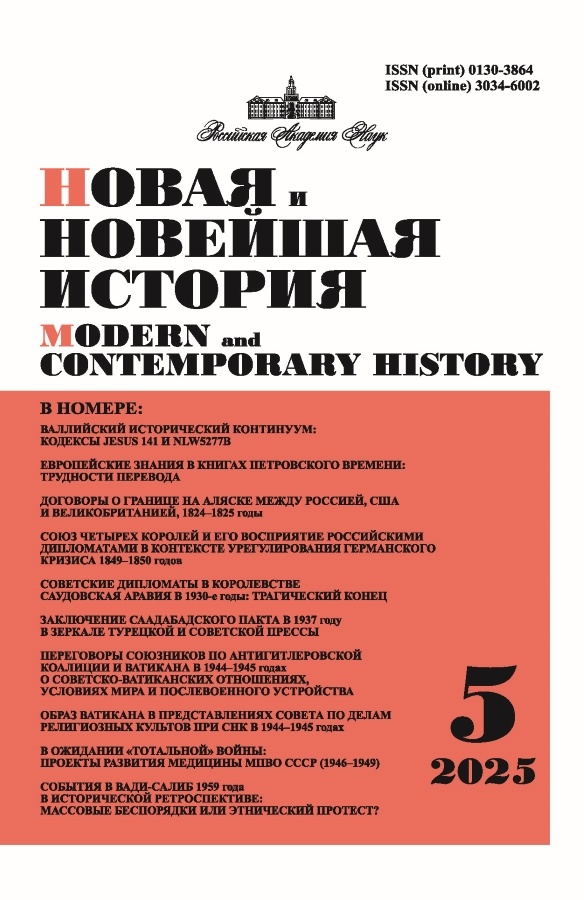Два образа Младотурецкой революции: общественная реакция в Бейруте и Дамаске на революционные события 1908 г. в Османской империи
- Авторы: Жантиев Д.Р.1
-
Учреждения:
- МГУ имени М. В. Ломоносова
- Выпуск: № 1 (2023)
- Страницы: 60-69
- Раздел: XX век
- URL: https://gynecology.orscience.ru/0130-3864/article/view/671098
- DOI: https://doi.org/10.31857/S013038640021317-6
- ID: 671098
Цитировать
Полный текст
Аннотация
В статье рассматривается реакция провинциального общества на события первого этапа Младотурецкой революции в Османской империи в 1908 г. на примере двух крупных центров сирийских провинций Османской империи – Бейрута и Дамаска. Ограничение младотурками власти султана-халифа Абдул-Хамида II вызвало неоднозначную, порой диаметрально противоположную реакцию на арабской периферии Османской империи, анализ которой необходим для понимания механизмов дальнейших отношений провинциальных элит с имперским центром. На основе консульских донесений и свидетельств ряда очевидцев событий показаны два образа младотурок и их действия в 1908 г. глазами бейрутской и дамасской общественности. В то время как в приморском Бейруте, служившем главными «морскими воротами» османской Сирии, либеральные настроения среди местных интеллектуалов и торговых семей (как мусульман, так и христиан) послужили почвой для позитивного и даже восторженного восприятия революции, в более традиционной и консервативной городской среде Дамаска восстановление действия конституции и ограничение султанской власти было воспринято настороженно-негативно. Разрушение системы отношений «патрон – клиент», связывавших крупных землевладельцев и мусульманских религиозных деятелей Дамаска с султанским двором, породило протестные настроения среди горожан, что, в свою очередь, осенью 1908 г. привело к массовым беспорядкам в Дамаске. Проведенное исследование опровергает распространенный тезис об однозначно позитивном восприятии Младотурецкой революции в арабских провинциях Османской империи.
Ключевые слова
Полный текст
Об авторах
Дмитрий Рустемович Жантиев
МГУ имени М. В. Ломоносова
Автор, ответственный за переписку.
Email: secretary_novistor57@mail.ru
Россия, Москва
Список литературы
- Сарабьев А.В. Дома, за рубежом. Миграции христиан Сирии и Ливана (вторая половина XIX – первая половина XX в.). М., 2012.
- Смилянская И.М., Горбунова Н.М., Якушев М.М. Сирия накануне и в период Младотурецкой революции. По материалам консульских донесений. М., 2015.
- Abu-Manneh B. Sultan Abdulhamid II and Shaikh Abulhuda Al-Sayyadi // Middle Eastern Studies. 1979. Vol. 15. № 2. P. 131–153.
- Der Matossian B. Formation of Public Sphere(s) in the Aftermath of the 1908 Revolution among Armenians, Arabs, and Jews // “L'ivresse de la liberté”. La revolution de 1908 dans l'Empire ottoman / ed. F. Georgeon. Paris, 2012. P. 189–219.
- Guardians of faith in modern times: “ulama” in the Middle East / ed. M. Hatina. Leiden; Boston, 2009.
- Haddad M. The Rise of Arab Nationalism Reconsidered // International Journal of Middle East Studies. 1994. Vol. 26. № 2. P. 201–222.
- Hanssen J. Fin de Siecle Beirut. The Making of an Ottoman Provincial Capital. Oxford; New York, 2005.
- Jessup H.H. Fifty-three years in Syria. Vol. II. New York, 1910.
- Karpat K.H. The Politicization of Islam: Reconstructing Identity, State, Faith, and Community in the Late Ottoman State. New York, 2001.
- Kayali H. Arabs and Young Turks: Ottomanism, Arabism and Islamism in the Ottoman Empire, 1908–1918. Berleley; Los Angeles; London, 1997.
- Kurd Ali M. Hitat al-Sham. Part 3. Dimashk, 1983. (In Arabic)
- Makzume E. Sultan II. Abdülhamid’in Hizmetinde Selim Melhame Paşa ve Ailesi. İstanbul, 2019.
- Massot A. Ottoman Damascus during the Tanzimat: The New Visibility of Religious Distinctions // Modernity, Minority, and the Public Sphere. Jews and Christians in the Middle East. Leiden; Boston, 2016. P. 155–184.
- Rashid Rida M. Rihlatan ilya Suriya (1908–1920). Beirut, 2001. (In Arabic)
Дополнительные файлы








